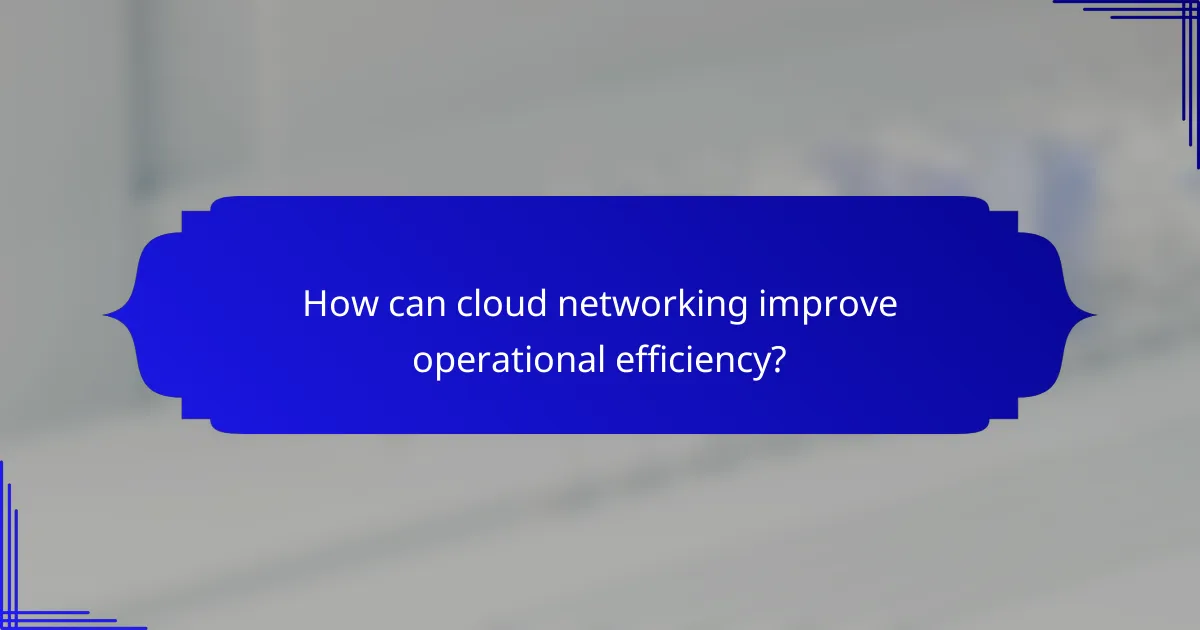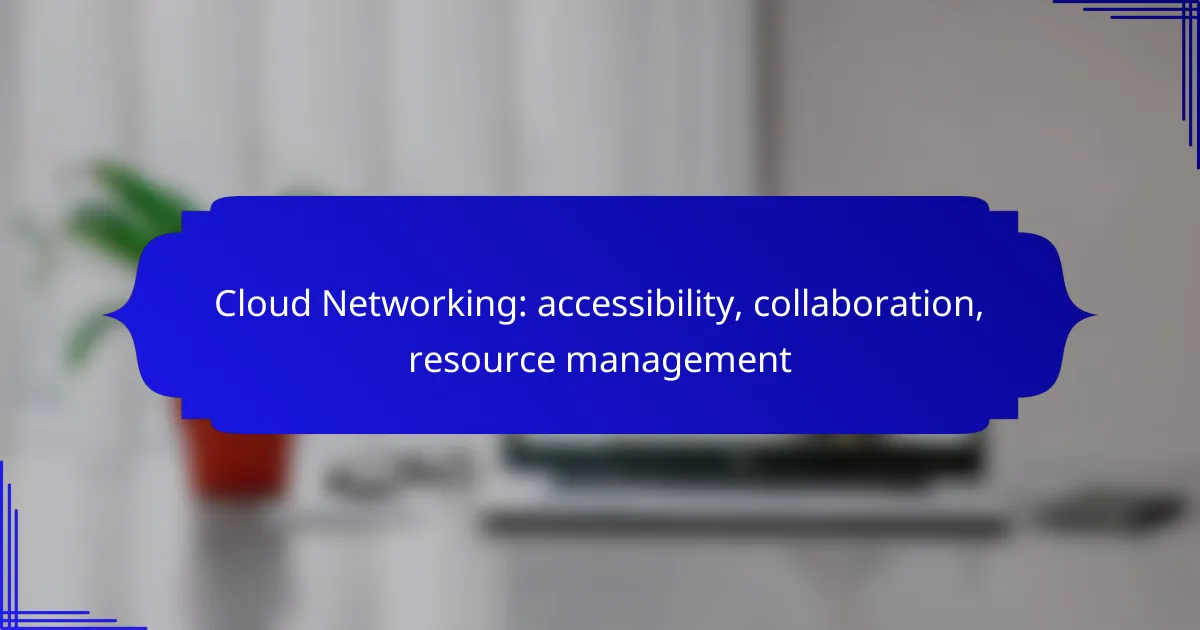Cloud networking revolutionizes accessibility by enabling users in New Zealand to connect to vital resources and applications from anywhere with an internet connection. This technology not only fosters collaboration among teams working remotely but also allows businesses to efficiently manage resources through automated systems and performance monitoring, ultimately enhancing productivity and cost-effectiveness.

How does cloud networking enhance accessibility in New Zealand?
Cloud networking significantly enhances accessibility in New Zealand by allowing users to connect to resources and applications from virtually anywhere with an internet connection. This flexibility supports a diverse range of devices and promotes collaboration across various locations.
Improved remote access
Cloud networking facilitates improved remote access by enabling users to connect to their work environments from home or while traveling. This is particularly beneficial in New Zealand’s rural areas, where traditional connectivity may be limited. Employees can access files, applications, and services without being tied to a specific physical location.
Utilizing cloud services, organizations can implement secure virtual private networks (VPNs) or use cloud-based applications that require only a web browser. This ensures that remote workers have the same access as those in the office, fostering productivity and collaboration.
Device compatibility
Cloud networking enhances device compatibility by allowing users to access services from various devices, including laptops, tablets, and smartphones. This cross-device functionality ensures that employees can work effectively, regardless of the hardware they use. In New Zealand, where diverse device usage is common, this flexibility is crucial.
Organizations should ensure that their cloud applications are optimized for multiple platforms and operating systems. This may involve testing applications on different devices to guarantee a seamless user experience, which can help avoid frustration and downtime.
Scalable solutions
Cloud networking offers scalable solutions that can grow with an organization’s needs. In New Zealand, businesses can easily adjust their cloud resources based on demand, whether they need to increase storage, processing power, or user licenses. This scalability allows companies to manage costs effectively and avoid over-investing in physical infrastructure.
When selecting cloud services, organizations should consider providers that offer flexible pricing models, such as pay-as-you-go or tiered pricing. This approach helps businesses align their cloud spending with actual usage, ensuring they only pay for what they need while maintaining the ability to scale as required.

What are the benefits of cloud networking for collaboration?
Cloud networking enhances collaboration by providing seamless access to tools and resources from any location. This flexibility allows teams to communicate effectively and work together on shared projects in real-time, regardless of their physical distance.
Real-time communication tools
Real-time communication tools are essential for effective collaboration in cloud networking. They enable instant messaging, video conferencing, and voice calls, allowing team members to connect and share ideas quickly. Popular platforms like Slack and Microsoft Teams facilitate these interactions, making it easy to maintain a continuous flow of information.
When selecting communication tools, consider factors such as user interface, integration capabilities, and security features. Ensure that the chosen tools support mobile access, as many team members may work remotely or on the go.
Shared resources and files
Cloud networking allows teams to share resources and files effortlessly, promoting collaboration on projects. Platforms like Google Drive and Dropbox enable users to store, access, and edit documents collectively, ensuring everyone is working with the latest information. This reduces the risk of version control issues and enhances overall productivity.
To maximize the benefits of shared resources, establish clear guidelines for file organization and naming conventions. Regularly review access permissions to ensure that only authorized team members can view or edit sensitive information.
Integration with collaboration platforms
Integrating cloud networking with collaboration platforms streamlines workflows and enhances productivity. Many cloud services offer APIs that allow seamless connections with tools like project management software and customer relationship management systems. This integration helps teams manage tasks, track progress, and communicate effectively within a single ecosystem.
When implementing integrations, prioritize platforms that align with your team’s specific needs and workflows. Regularly evaluate the effectiveness of these integrations to ensure they continue to support your collaboration goals efficiently.

How can businesses manage resources effectively with cloud networking?
Businesses can manage resources effectively with cloud networking by leveraging automated systems, cost management tools, and performance monitoring. These strategies help optimize resource usage, control expenses, and ensure that applications run smoothly.
Automated resource allocation
Automated resource allocation allows businesses to dynamically assign computing resources based on real-time demand. This means that during peak usage, additional resources can be provisioned automatically, while during low usage, resources can be scaled back to save costs.
For instance, a retail company experiencing high traffic during a sale can automatically increase its server capacity without manual intervention. This flexibility ensures that businesses only pay for what they use, leading to more efficient resource management.
Cost management features
Cost management features in cloud networking provide tools to track and optimize spending on cloud resources. Businesses can set budgets, receive alerts for overspending, and analyze usage patterns to identify areas for cost reduction.
Using these features, a company can implement strategies such as reserved instances for predictable workloads, which can save up to 70% compared to on-demand pricing. Regularly reviewing billing reports helps in making informed decisions about resource allocation and usage.
Performance monitoring tools
Performance monitoring tools are essential for ensuring that cloud resources are functioning optimally. These tools provide insights into resource utilization, application performance, and potential bottlenecks, allowing businesses to proactively address issues.
For example, a company can use monitoring tools to track server response times and identify when performance dips below acceptable levels. By setting up alerts, businesses can quickly respond to performance issues, ensuring a seamless experience for users and maintaining productivity.

What criteria should businesses consider when choosing a cloud networking provider?
Businesses should evaluate several key criteria when selecting a cloud networking provider, including security features, service level agreements, and customer support options. These factors directly impact the reliability, safety, and overall effectiveness of cloud networking solutions.
Security features
Security features are crucial when choosing a cloud networking provider, as they protect sensitive data and ensure compliance with regulations. Look for providers that offer encryption, multi-factor authentication, and regular security audits.
Consider whether the provider adheres to industry standards such as ISO 27001 or GDPR, which can enhance trust in their security measures. Additionally, assess their incident response protocols to understand how they handle potential breaches.
Service level agreements
Service level agreements (SLAs) define the expected performance and reliability of the cloud service. A strong SLA should specify uptime guarantees, typically around 99.9%, and outline penalties for non-compliance.
Evaluate the terms regarding data recovery, backup frequency, and maintenance schedules. Clear SLAs help ensure that your business can rely on the cloud provider for consistent service delivery.
Customer support options
Customer support options are vital for resolving issues quickly and minimizing downtime. Look for providers that offer 24/7 support through multiple channels, such as phone, chat, and email.
Assess the responsiveness and expertise of the support team by reviewing customer testimonials or conducting a trial. A provider with robust support can significantly enhance your cloud networking experience and help address challenges effectively.

How can cloud networking improve operational efficiency?
Cloud networking enhances operational efficiency by enabling seamless access to resources and facilitating collaboration among teams. This technology reduces costs, improves flexibility, and allows organizations to respond quickly to changing demands.
Streamlined workflows
Cloud networking simplifies workflows by centralizing resources and tools in a single accessible platform. Teams can collaborate in real-time, eliminating delays caused by email exchanges or file transfers. For instance, using cloud-based project management tools can lead to faster task completion and improved communication.
To maximize streamlined workflows, organizations should adopt integrated cloud solutions that connect various applications. This reduces the need for manual data entry and minimizes errors, ultimately speeding up processes.
Reduced downtime
Cloud networking significantly reduces downtime by providing reliable, redundant systems that ensure continuous availability. With cloud services, businesses can quickly switch to backup systems in case of hardware failures or outages, minimizing disruptions. Most cloud providers offer service level agreements (SLAs) that guarantee uptime of 99.9% or higher.
To further mitigate downtime, organizations should regularly test their disaster recovery plans and ensure that their cloud infrastructure is properly configured for failover. This proactive approach helps maintain operational continuity and enhances overall reliability.
Enhanced data management
Cloud networking improves data management by offering scalable storage solutions and advanced analytics capabilities. Organizations can store vast amounts of data securely and access it from anywhere, facilitating better decision-making and insights. Cloud platforms often provide tools for data organization, making it easier to retrieve and analyze information.
To optimize data management, businesses should implement data governance policies that define access controls and compliance standards. Regularly reviewing data usage and storage can help identify inefficiencies and reduce costs associated with unnecessary data retention.

What are the emerging trends in cloud networking for 2024?
In 2024, cloud networking is set to evolve with significant trends focusing on artificial intelligence and sustainability. These trends will enhance accessibility, collaboration, and resource management across various sectors, driving efficiency and environmental responsibility.
Increased adoption of AI
The integration of artificial intelligence in cloud networking will streamline operations and improve decision-making. AI can automate routine tasks, analyze network performance in real-time, and predict potential issues before they escalate, leading to enhanced reliability.
Organizations should consider implementing AI-driven tools that offer predictive analytics and automated network management. For instance, using AI algorithms can help optimize bandwidth allocation, ensuring that resources are used efficiently and reducing operational costs.
Focus on sustainability
Sustainability is becoming a critical focus in cloud networking as companies strive to reduce their carbon footprint. Cloud providers are increasingly adopting energy-efficient technologies and renewable energy sources to power their data centers, aligning with global environmental goals.
Businesses should evaluate their cloud service providers based on sustainability practices. Opting for providers that prioritize green technologies can not only enhance corporate responsibility but also improve brand image among environmentally conscious consumers.
